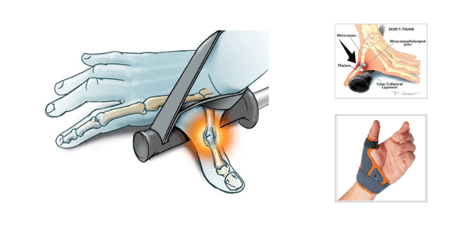Treatment for Gamekeeper's and Skier's Thumb
The thumb metacarpal phalangeal (MP) joint has a collateral ligament at the radial and ulnar aspect of the joint which provides stability for static lateral pinch. The ulnar collateral ligament (UCL) is susceptible to injury when radial deviation and hyperextension force is applied to the MP joint. The “classic” acute Skier’s thumb occurs when the thumb is forcefully abducted and hyperextended by the pole during a fall. Gamekeeper's thumb is differentiated from Skier’s Thumb as a chronic, repetitive stress condition caused by resistive grasping and twisting activities that stretch or tear the UCL over time.
Evaluation for Gamekeeper's and Skier's Thumb
A suspected thumb MP joint UCL injury should be checked for laxity at the ligament. This is performed with an ulnar stress applied to the thumb proximal phalanx while the metacarpal is supported radially and the thumb is in 30 degrees of flexion at the MP joint (to eliminate support of the volar plate).
It has been suggested that 30 to 40 degrees of laxity or laxity that is at least 15 degrees greater than the non-involved thumb indicates a complete rupture of the ligament. Thumb MP joint laxity is not uncommon so testing always needs to be completed bilaterally for comparison. Radiographs, MRI, and ultrasound for soft tissue imaging may also used in diagnosing a UCL injury.
Treatment Options
| Type | Description | Treatment |
| Partial or minimally displaced UCL tear or UCL Sprain | Pain with palpation, no obvious laxity with stress testing or laxity comparable to the non-involved thumb | Full time use of an orthosis that prevents stress to the thumb MP joint for 4-6 weeks to allow healing and scarring of the UCL (Many physicians prefer a forearm based orthosis initially to ensure no stress is applied to the joint) |
| UCL Tear | A complete tear of the UCL can be identified with obvious laxity during stress testing (see above) or with imaging of the soft tissue | Usually requires surgical repair of the ligament or reconstruction of a chronic tear (Less than 3 mm of displacement of the ligament has been found to respond to conservative immobilization) |
| UCL Tear with Avulsion Fracture | Injury to the UCL with avulsion fracture of the thumb proximal phalanx where the UCL inserts onto the bone | If the fracture is stable, casting or full time orthosis use protecting the thumb MP joint is recommended. When the fracture is not stable, surgery is needed for fracture stabilization. |
| UCL Tear with Stener’s Lesion | The adductor aponeurosis is interposed between the distally avulsed UCL and its attachment on the base of the proximal phalanx, which prevents healing (and may be palpated) | Surgery is required for repair of the ligament |
Following surgery, immobilization for the MP joint with a removable orthosis is often recommended for protection. If left untreated, a tear in the UCL of the thumb MP joint may cause loss of pinch strength, further deformity of the thumb, and arthritis in the MP joint.
There are several designs to assist with rehabbing from a thumb MP UCL injury. Consider trying the ThumSaver MP, The Fix Comfort Thumb Brace or 3pp Ez FIT Thumb Spica Splint for the later healing stages.
 |
 |
 |
| ThumSaver MP | Fix Comfort Thumb Brace | 3pp Ez FIT Thumb Spica Splint |




